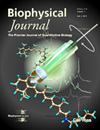Predicting Side Chain Conformations in Folded Proteins by AlphaFold: Perspective and Challenges.
IF 3.1
3区 生物学
Q2 BIOPHYSICS
引用次数: 0
Abstract
AlphaFold has revolutionized protein structure prediction by accurately creating 3D structures from just the amino-acid sequence. However, a key question important for the molecular modeling field remains: Can AlphaFold predict the conformations of individual amino-acid residue side chains within a folded protein? Herein, we investigate the ability of ColabFold, an online implementation of AlphaFold2, and AlphaFold3 to predict the side-chain conformations in folded proteins. We find that over a set of 10 benchmark proteins (set A) representing several different highly-populated fold families, which are included in the AlphaFold protein structure database, the side-chain conformation prediction error of ColabFold is ∼14% for χ1 dihedral angles, and increases to ∼48% for χ3 dihedral angles. Prediction error is smaller for non-polar side chains and is somewhat improved using structural templates. ColabFold demonstrates a bias towards the most prevalent rotamer states in protein data bank, potentially limiting its ability to capture rare side-chain conformations effectively. Additionally, for 10 recently-released protein structures, which were not employed in the training of AlphaFold2, we show that ColabFold predicts side-chain conformations with almost the same accuracy as for the set A. Also, we demonstrate the side-chain prediction accuracy by AlphaFold3 is slightly better than by ColabFold. As an application of AlphaFold to explore the structural consequences of strongly cooperative mutations on side-chain rearrangements, we employ a Potts sequence-based statistical energy model to perform large scale mutational scans of two proteins ABL1 and PIM1 kinase, searching for the most strongly cooperative mutational pairs, and then use ColabFold to predict the structural signatures of this cooperativity on the interacting side chains. Our results demonstrate that integration of the sequence-based Potts model with AlphaFold into a single pipeline provides a new tool that can be used to explore the fundamental relationship between protein mutations, and cooperative changes in structure, and fitness.用AlphaFold预测折叠蛋白侧链构象:前景和挑战。
AlphaFold通过仅从氨基酸序列精确创建3D结构,彻底改变了蛋白质结构预测。然而,对于分子建模领域来说,一个重要的关键问题仍然存在:AlphaFold能否预测折叠蛋白质中单个氨基酸残基侧链的构象?在此,我们研究了ColabFold (AlphaFold2和AlphaFold3的在线实现)预测折叠蛋白侧链构象的能力。我们发现,在AlphaFold蛋白结构数据库中包含的代表几种不同高密度折叠家族的10个基准蛋白(a组)中,对于χ1二面角,ColabFold的侧链构象预测误差为~ 14%,对于χ3二面角,则增加到~ 48%。非极性侧链的预测误差较小,使用结构模板可以有所改善。ColabFold偏向于蛋白质数据库中最普遍的旋转体状态,这可能会限制其有效捕获罕见侧链构象的能力。此外,对于最近发布的10个未用于AlphaFold2训练的蛋白质结构,我们表明ColabFold预测侧链构象的准确性与a集几乎相同,并且我们证明了AlphaFold3的侧链预测精度略好于ColabFold。为了探索侧链重排中强合作突变的结构后果,我们采用基于Potts序列的统计能量模型对两种蛋白质ABL1和PIM1激酶进行大规模突变扫描,寻找最强合作突变对,然后使用ColabFold预测相互作用侧链上这种合作性的结构特征。我们的研究结果表明,将基于序列的Potts模型与AlphaFold整合到一个单一的管道中,提供了一个新的工具,可用于探索蛋白质突变,结构和适应度的协同变化之间的基本关系。
本文章由计算机程序翻译,如有差异,请以英文原文为准。
求助全文
约1分钟内获得全文
求助全文
来源期刊

Biophysical journal
生物-生物物理
CiteScore
6.10
自引率
5.90%
发文量
3090
审稿时长
2 months
期刊介绍:
BJ publishes original articles, letters, and perspectives on important problems in modern biophysics. The papers should be written so as to be of interest to a broad community of biophysicists. BJ welcomes experimental studies that employ quantitative physical approaches for the study of biological systems, including or spanning scales from molecule to whole organism. Experimental studies of a purely descriptive or phenomenological nature, with no theoretical or mechanistic underpinning, are not appropriate for publication in BJ. Theoretical studies should offer new insights into the understanding ofexperimental results or suggest new experimentally testable hypotheses. Articles reporting significant methodological or technological advances, which have potential to open new areas of biophysical investigation, are also suitable for publication in BJ. Papers describing improvements in accuracy or speed of existing methods or extra detail within methods described previously are not suitable for BJ.
 求助内容:
求助内容: 应助结果提醒方式:
应助结果提醒方式:


